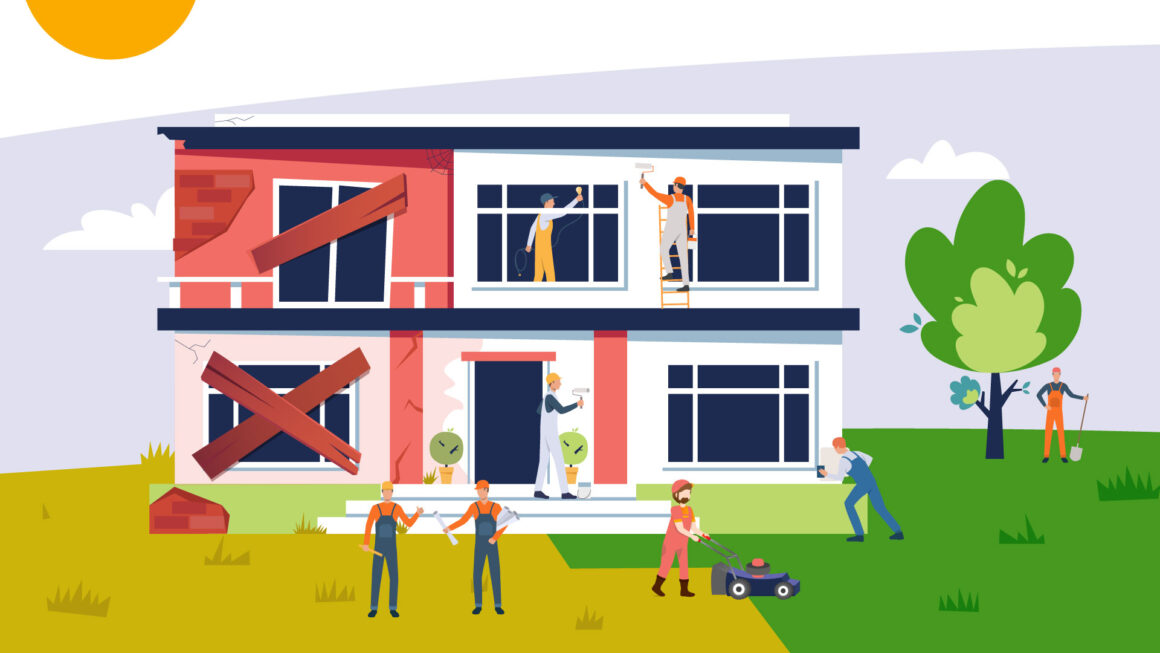Application modernization has become an important part of any successful digital transformation process and it’s here to stay.
If there is one thing to be certain of is that technology evolves fast. The last two decades brought a true explosion in terms of digital innovation and progress. As a consequence, companies are starting to feel the pressure of keeping up with the latest trends and needs of digital industrialization.
Table of Contents
- What is Application Modernization?
- How Application Modernization Works
- What are Legacy Applications
- Why Modernize Your Company’s Legacy Applications?
- Application Modernization Patterns
- Most Used Technologies for Application Modernization
- Types of Application Modernization Services
- App Modernization Example
What is Application Modernization?
Application modernization is the process of updating old software. This means newer computing methodologies, newer programming languages, infrastructure, frameworks and more.
Sometimes, you’ll also find the terms “legacy modernization”, “legal application modernization” or “legacy systems” used for explaining app modernization.
Although app modernization usually refers to migrating a legacy (outdated) app to cloud hosting, it can look different based on each need. Here are some examples of app modernization solutions:
- Translation of legacy code into more modern languages
- Database migration from local hosting to cloud storage.
- Implementing new secure ways for data access.
- Integrating AI and machine learning into an existing app.
- Virtual Machine migration to Native Containers
- Or simply cloud migrating from one provider to a more modern and secure one.
To better understand what app modernization means in the IT world, think of renovating your grandma’s old house. The building is fine, but it needs a lot of improvements to meet the guidelines for safe and sustainable living. So all the updates you will do to this old house are meant to make it more efficient and more comfortable to live in (which could also translate into “more user friendly” for a digital product).
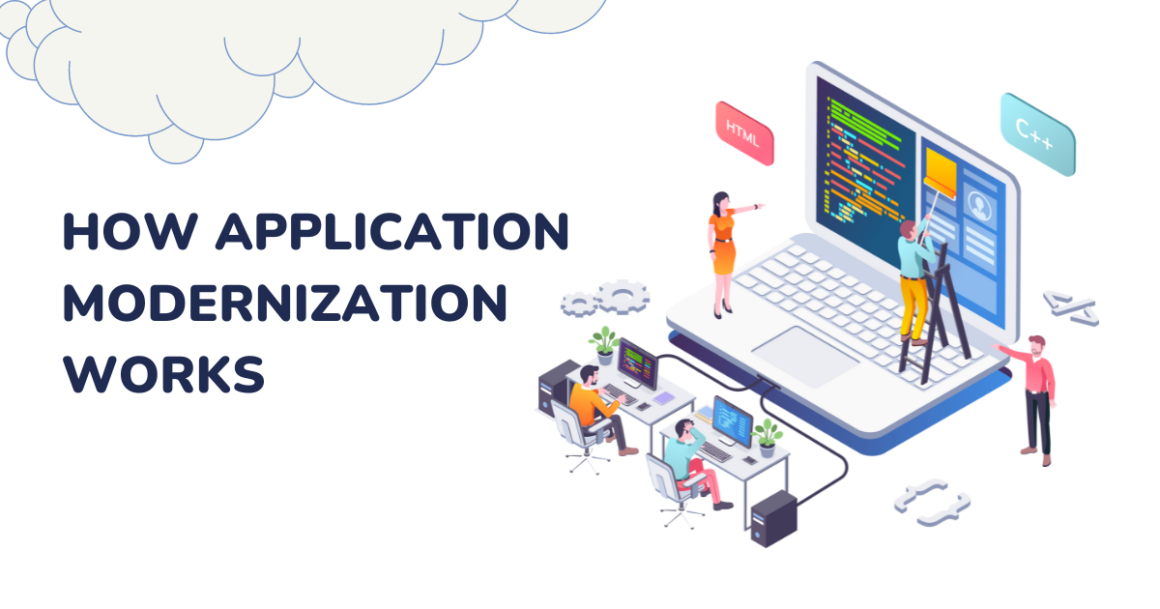
How Application Modernization Works
Based on each company’s unique need, application modernization will follow different methodologies. But the main four steps are:
- assessing and analysing the old system
- planning
- implementation
- observing and optimizing
Analysing the old system is the most important step of app modernization since defining the problems will determine the modernization approach.
After the organisation evaluates and assesses the existing app situation, they can move on to step number two.
Planning – This step is an excellent opportunity to go deep into details and sketch a solid implementation plan.
Here, the company, together with the app modernization service provider decide how the application will be updated, by choosing the best modernization pattern.
The implementation stage is where the “main action” happens. In this step, the designated app goes through the modernization process. This will look different based on:
- the service provider
- the app type that’s upgraded
- new programming languages used and much more
This one is probably the most laborious step since it involves more people, clear workflows and a lot of collaborative work in order to get the best possible results.
Observing and optimizing can be compared to the maintenance and support stage, in software development.
In a way, the modernization process is continuous. Once the modernized application is integrated with the existing environments, it is monitored to see if it performs as expected.
And unless we want the app to risk becoming a legacy app, it needs to be regularly updated.
Find out if your system needs modernization!
What are Legacy Applications
In the computing industry, a legacy application is a technology, computerised system, or application program that is still being used, even though it is outdated. Replacing legacy applications with up-to-date systems based on new and different technologies is crucial for the proper functionality of the whole application process.
Think about an old house that can still be used as a living space, but needs improvements for safety, energy efficiency, and comfort reasons.
In the digital world, a good example is a desktop app designed to work on the Windows XP operating system (Windows XP has been discontinued since 2008). In order to use this desktop app on Windows 10 or 11, the app needs to be modernized.
Any business software that is not Internet-enabled can be considered a legacy application.

Why Modernize Your Company’s Legacy Applications?
There can be different reasons why a company wants to modernize legacy applications. From security concerns to staying on top in their industry, each reason also represents a benefit of application modernization.
Cost Management
Examining the continued cost of maintaining a legacy system against the cost and migration of application modernization, many companies can conclude that the latter is more cost-efficient.
A savvy adoption of cloud resources can greatly reduce infrastructure, maintenance, and development costs, thus improving the overall cost optimization of the tool.
Enhance Productivity and Customer Experience
Working with outdated technologies can bring a lot of challenges: difficulty to find software engineers who still possess the knowledge, extra space and logistics for hosting them locally and maybe unhappy users.
Migrating a locally-hosted app to the cloud can significantly accelerate application performance and improve users’ productivity.
Cloud-based apps are accessible anytime, anywhere, so employees won’t be tied to their office desks anymore.
Quick fixes and updates can be done faster, communication is more fluid and the overall customer experience is improved.
Strengthen Security
In 2022, every company knows that its applications’ and workstations’ security is key to protecting a company from financial loss, reputational harm, consumer trust degradation, and brand erosion.
There’s no secret that on-premise servers are more vulnerable to cyberattacks due to actions of phishing and email-borne threats.
Cloud hosting, however, keeps the important data separately from the workstations. It offers integrated encryption, and secure access by enabling multifactor authentication or even limited access by IP address.
Therefore, more and more companies look into cloud solutions for their security needs.
Stay Relevant
Adaptability is key when it comes to staying relevant in the IT industry.
A good adaptability trend example is when almost everyone made their digital products available in the mobile app format. Companies that refused to embrace this mobile trend, were left behind.
In this fast-paced era of digitalization, users want to have access to the latest technologies on their devices anywhere in the world, while being on the move. They need more secure, user-friendly apps that address their constantly evolving needs.
So, to ensure businesses meet market standards, they need to keep all their systems up-to-date and deliver the best user experience for their customers.
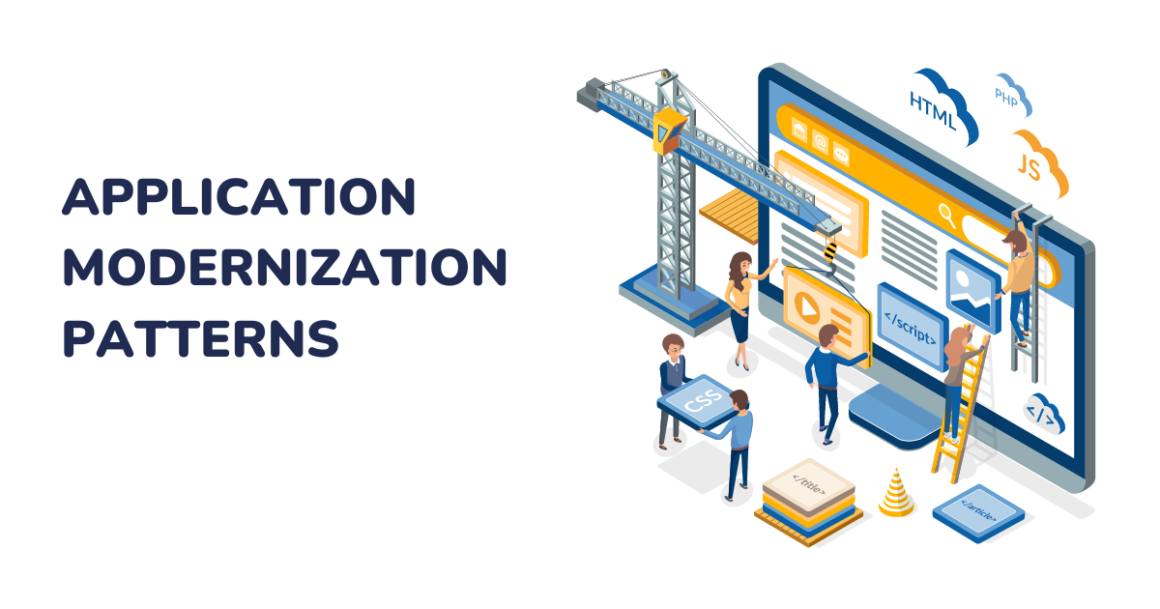
Application Modernization Patterns
App modernization patterns are also referred to as application modernization strategies.
The most common 6 app modernization patterns are
- Rehost – sometimes also called “lift and shift”. This strategy doesn’t involve any coding. It simply means moving the legacy app from an old environment to its new environment.
- Replatform – a middle strategy between rehosting and refactoring. This strategy involves making code changes to the mainframe application so that the app can be hosted in the cloud.
- Refactor – involves minimal code changes in order to make the most of the cloud-first environment. This pattern is linked to increased speed and productivity.
- Rearchitect – applied when cloud scaling is needed. Rearchitecting is a complex procedure since it involves modifying app functionality and code, in order for the app to scale better in the cloud.
- Re-build – applicable for apps which need only specific functionalities to be modernized. This approach to application modernization focuses on identifying the key legacy components that need modernization and building them again without changing the application scope. Re-building the legacy components functionality by functionality presents high adaptability for the end-user while increasing application performance.
- Replace – probably the most complex strategy. This means completely replacing the existing applications with new ones. This approach is needed when rebuilding isn’t enough for the business needs. It can also be faster and more efficient than rebuilding. As a drawback, this modernization pattern can bring some limitations or interruptions to the company’s processes, since it involves starting an app development process from scratch.
As you can see, there are different approaches that can accommodate different needs and resources.
Because modernizing existing apps is a flexible and adaptable process, these patterns can also overlap.
Based on a company’s objectives and resources, they can pick one of the six patterns we described above. Of course, an app modernization service provider is best suited to advise and guide you through the decision-making process.
Ready to migrate to the cloud?
Most Used Technologies for Application Modernization
When talking about key technologies for application modernization, it is important to underline that most of them will gravitate toward cloud services.
Here at Fabrit Global, most of the digital products we develop are hosted using Microsoft Azure cloud computing services, as part of our Microsoft Silver Partner certification.
Besides Microsoft Azure, other popular cloud providers are Google Clouds and AWS (Amazon Web Services) Cloud Computing Services.
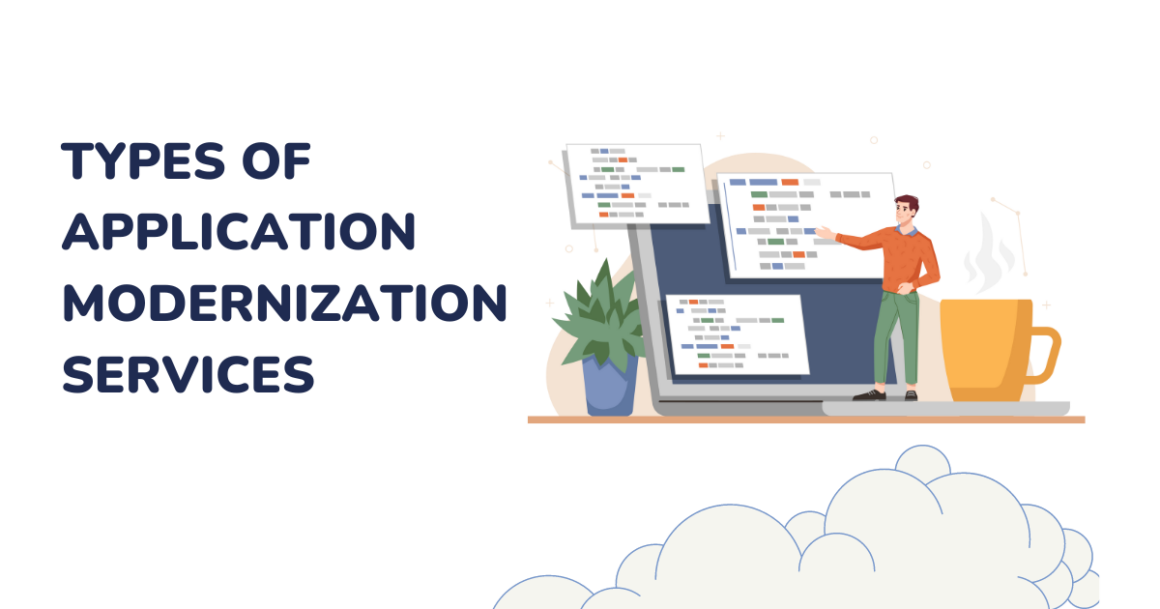
Types of Application Modernization Services
Similarly to the patterns and strategies available, there are different types of services that companies can look into to implement their modernization strategy.
Usually, app modernization services will be grouped like this:
- Automation
- Microservices
- APIs
- Cloud Services
Automation services include automating manual processes such as in deploying, managing and scaling containerized applications. Automation is important for new ways of working as DevOps and faster release cycles. Most automation services rely on Kubernetes – an open-source container orchestration system for automating software deployment, scaling, and management, initially developed by Google.
Microservices imply breaking down the app into individual, independent components. They are mainly an architectural and organisational approach to software development. However, this approach is an interesting option for software modernization due to its smaller code bases and strong component separation.
APIs are all about integration. Application Programming Interfaces (APIs) will help connect different apps and systems within the organisation, in order to help them communicate with each other. This brings significant efficiency and accessibility improvement.
Cloud Services are probably the most often associated services with app modernization. With the help of cloud platforms, the data flow between front-end devices (phones, tablets, laptops, desktops, etc.) to the provider’s system and back, is smoother and faster. Cloud adoption is vital when it comes to improving app accessibility.
Modernization solutions can be adapted to each need. In terms of switching to a cloud infrastructure, clients can choose from different types of cloud hosting (public, private, hybrid or multi-cloud). Your cloud computing software provider can advise you on which type of service is best suited for your need.
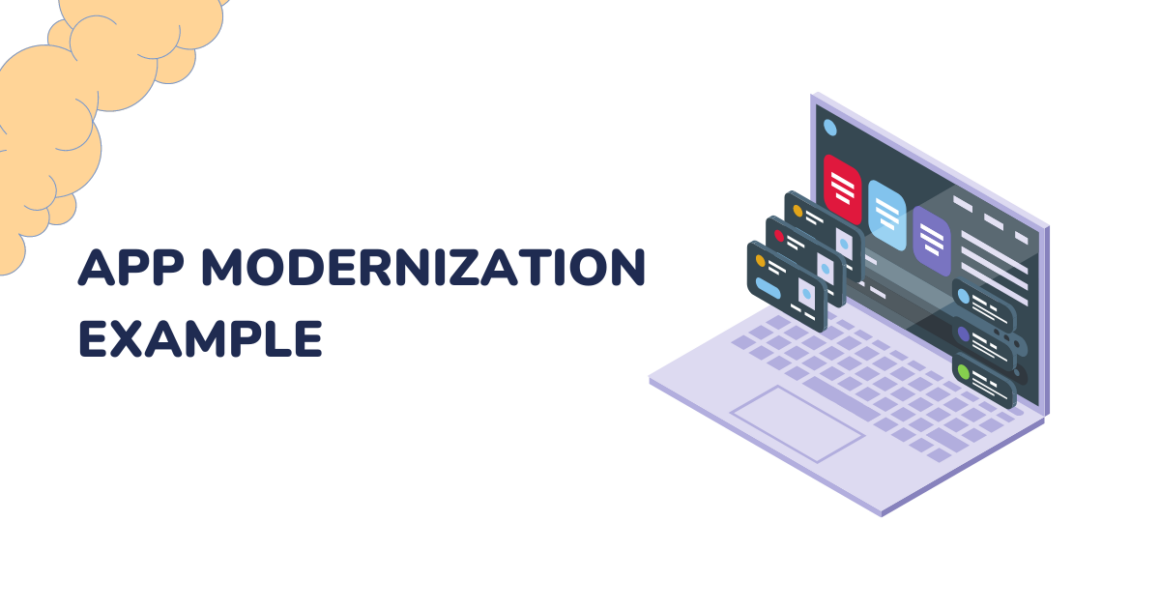
App Modernization Example
Turning old web & desktop applications into a new, unified application
Context: The client was using a legacy system composed of different modules: a desktop one for their internal use, multiple data handling modules for data gathering and manipulation, an old web portal with legacy technologies, and multiple databases with duplicated data and synchronisation mechanisms between them.
The challenge: to incorporate important functionalities from the existing apps and add new functionalities on top, while improving the existing code base and software architecture.
The process:
- Analysing the current system and the client’s business
- Understanding the client’s requirements and vision of the product
- Creating a system modernization roadmap which took into consideration two main aspects:
- Functional requirements from the client for a quick win for the users
- Technical requirements for a more robust system
- System implementation based on the agreed roadmap and the client budget
Result: The final system got rid of the old desktop module, moving it to a fully cloud platform, removing the need for multiple databases and synchronisation mechanisms, and porting the development code to newer web technologies.
Conclusion
Migrating and modernizing is a must for companies that have been doing business for a while.
Modernizing apps increase application and data availability, scalability, and performance.
App modernization is a smart strategy to keep up with the latest technology needs and trends and upgrade industry solutions while helping companies solidify their commitment to their clients.
Are you ready to upgrade your business process and modernize your software?


